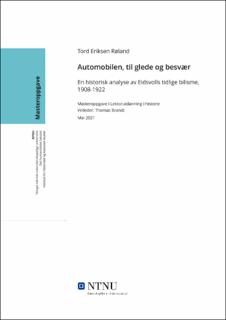| dc.contributor.advisor | Brandt, Thomas | |
| dc.contributor.author | Røland, Tord Eriksen. | |
| dc.date.accessioned | 2021-09-13T16:10:54Z | |
| dc.date.available | 2021-09-13T16:10:54Z | |
| dc.date.issued | 2021 | |
| dc.identifier | no.ntnu:inspera:80290154:10000436 | |
| dc.identifier.uri | https://hdl.handle.net/11250/2775800 | |
| dc.description.abstract | Denne avhandlingen undersøker ulike forståelser, forhandlinger og sosiokulturelle prosesser ved den tidlige bilismen hos Eidsvolls lokalbefolkning fra 1908 til 1922. Inspirert av diskursanalyse og teorien om social construction of technology (SCOT) er analysen gjort på grunnlag av de diskursene som oppstod i Eidsvoll herred omkring bilisme i denne perioden. I hovedsak er tekst fra herredsstyreprotokoller og lokalavisene Eidsvold Blad og Eidsiva undersøkt for å få oversikt over forskjellige holdninger hos enkeltaktører og forskjellige interessegrupperinger. Denne oppgaven viser at forskjellige aktører utrykte ulike syn på bilen. Noen utviste en positiv holdning, og oppfattet den som en moderne og fremtidsrettet teknologi. Andre utrykte en ambivalent holdning, hvor bilen ble tolket både positivt og negativt. Ikke minst var det mange som utviste en stor grad av skeptiske og negative holdninger, da bilen kunne bli oppfattet som et skremmende og potensielt farlig kjøretøy. Mitt argument er at perioden fra 1908 til 1922 var preget av mange ulike og skiftende holdninger til bilismen i Eidsvoll. Positive og negative uttalelser kom til uttrykk igjennom hele tidsrommet. For perioden som helhet, ser det ut til å ha forekommet en endring i den generelle holdningen. Mens flere ønsket å forby eller kraftig begrense bilen fra å kjøre på veiene i herredet i 1908, var bilen blitt mer akseptert som en integrert del av lokalsamfunnet i 1922. Bakgrunnen for de ulike aktørers forståelse av bil var komplisert og mangefasettert. Det var et samspill mellom ulike fenomener som påvirket synet på den tidlige bilismen. Bilen ble tolket i ulike kontekster. Den var blant annet en ny teknologisk gjenstand, men den var også en utfordrer til datidens tradisjonelle veibruk. Bilen la press på eksisterende regelverk, infrastruktur og lokal kultur. Samtidig oppstod det nye typer sosiokulturell atferd rundt bilen som også formet forståelsen av motorvognen. Alle disse faktorene medvirket i å skape ulike forståelser av bilismen i Eidsvoll. | |
| dc.description.abstract | This master thesis examines different perceptions, negotiations, and sociocultural processes of Eidsvoll’s local population, concerning the early period of automobilism from 1908 to 1922. Inspired by discourse analysis and the theory of Social construction of technology (SCOT) this historical analysis is based on different occurrences of discourse concerning automobilism which arose in the municipality of Eidsvoll, in this time period. By mainly examining written text from the meeting minutes of the municipal counsel and the local newspapers Eidsvold Blad and Eidsiva, this thesis acquires an overview of the different attitudes of individuals and interest groups within the community. This thesis shows that these individuals and groups expressed contrasting views regarding automobiles. Some exhibited a positive attitude and perceived the motorcar as a modern and future-oriented technology. Others expressed an ambivalent attitude and interpreted the technology as being both positive and negative. Many also expressed skeptical and negative attitudes since the car was understood by many as a frightening and potentially dangerous vehicle. My main argument is that the timespan from between 1908 to 1922 was characterized by many different and alternating views on the automobilism in Eidsvoll. Both positive and negative statements were expressed recurringly within the entire period. Considering the time frame, as a whole, there seems to have been a shift in the general attitudes towards motorcars. While many expressed a desire to prohibit or strongly limit cars from using the local roads within the municipality in 1908, the car had, on the contrary, largely become accepted within the local community in 1922. The reasons behind these different attitudes towards the automobile were complex and multifaceted. There was an interplay between different factors which affected peoples understanding. The motorcar was interpreted in different contexts. It was a new technological object, but it also challenged the traditional usage of roads. The car also created a pressure on existing legislation, infrastructure, and local culture. At the same time, new sorts of sociocultural behaviors developed in relation to the car, which also helped shape the perception of the motorcar. All these factors contributed to creating different understandings of the automobilism in Eidsvoll. | |
| dc.language | nob | |
| dc.publisher | NTNU | |
| dc.title | Automobilen, til glede og besvær: En historisk analyse av Eidsvolls tidlige bilisme, 1908-1922. | |
| dc.type | Master thesis | |
